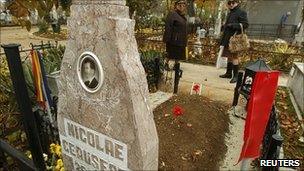Exhumed Romania body is Nicolae Ceausescu, tests show
- Published

The bodies of Ceausescu and his wife were buried hastily after their execution by firing squad
Scientists in Romania have confirmed that a body exhumed in a cemetery in the capital Bucharest is that of former dictator Nicolae Ceausescu.
The remains were exhumed, along with those believed to be of Ceausescu's wife, Elena, earlier this year so DNA tests could confirm their identities.
The couple's relatives had cast doubt on the official story that they were buried in the Ghencea cemetery.
Ceausescu ruled Romania from 1965 until he was toppled in the 1989 revolution.
He and his wife were tried and executed by a military court on Christmas Day 1989 after fleeing mass protests in Bucharest.
The execution took place at an army base near the town of Targoviste and the bodies were buried hastily, leaving some to doubt whether the graves in Bucharest really contained their remains.
"The DNA from his brother and his son show that it is Nicolae Ceausescu," Dan Dermengiu, head of Romania's legal medicine institute told the Mediafax news agency.
He said that in the case of Elena Ceausescu there was not enough material available for a conclusive test.
However, Ceausescu's son Valentin, a 62-year-old nuclear physicist, said he was now satisfied that his parents are buried in the graves where the authorities have always claimed they were.
He now wants to re-bury them at the same cemetery in adjacent plots, he told the Associated Press. They had been buried about 20m (65ft) apart.
The exhumations took place in the early hours of 21 July following a five-year court battle by the Ceausescu family.
At the time, Mircea Oprean, husband of the dictator's late daughter Zoia, said he thought it likely they were indeed the Ceausescus.
"I saw the bodies. My father-in-law's was quite well preserved, I recognised his black winter coat with some holes in it, presumably bullet holes," he said.
- Published21 July 2010